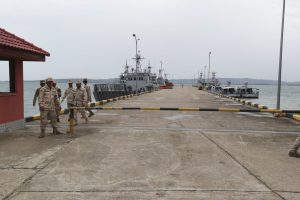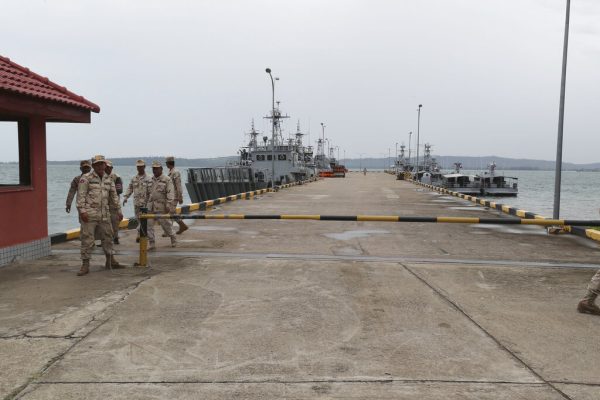ASEAN Beat | Security | Southeast Asia
Much discussion about China’s role in the refurbishment of the base has overlooked Phnom Penh’s own economic and security imperatives.

Cambodian navy troop members walk at Ream Naval Base in Sihanoukville, southwestern of Phnom Penh, Cambodia on July 26, 2019.
Credit: AP Photo/Heng Sinith, File
Cambodia’s ironclad friendship with China is once again in the regional spotlight with news that the Chinese-funded renovation of the Ream Naval Base on the country’s south coast is nearly finished. The controversy over the deep-sea port at the naval base revolves around its potential for hosting aircraft carriers and other vessels from the Chinese navy in a challenge to the U.S. naval presence in Southeast Asia. On July 24, the Financial Times referred to it as a “Chinese base in Cambodia.” But where do Cambodia and its interests fit into the discussion?
As some have already pointed out, understanding the development of the naval base through the lens of Sino-American competition risks assuming that Cambodia lacks agency in its own foreign policy. Other regional experts have noted that the Cambodian government’s surprising and repeated condemnation of the Russian invasion of the Ukraine demonstrates a concerted effort to reduce its dependence on Chinese influence and improve its relations with the West. Therefore, largely absent from the debate on the naval base are the national interests of the Cambodian government, particularly its desire to enhance the capabilities and facilities of the Royal Cambodian Navy, and the broader context of economic development.
The development of the Ream Naval Base touches upon the number one priority outlined in the Cambodian government’s 2022 National Defense Policy: border defense. In the wake of the 2008-2011 Preah Vihear conflict with Thailand, the Royal Cambodian Armed Forces have been engaged in wide-ranging military reforms for the purpose of protecting Cambodia’s sovereignty and territorial integrity. Immediately after armed clashes with Thailand in 2008, the Cambodian government announced the doubling of its military budget. Although Chinese military assistance, loans and training are clearly integral to Cambodia’s military reforms, the Japanese government has also successfully engaged the Cambodian government in the economic and security realms. This extends to military cooperation, which was recently strengthened under a memorandum of understanding and which involves the regular holding of the Japan-Cambodia Politico-Military Dialogue.
Last year, the Japanese government announced a loan of $300 million to construct additional terminals at Sihanoukville Autonomous Port. This development seeks to expand Cambodia’s capacity to export goods internationally, which in turn reduces its reliance on neighboring ports. A vessel from the Japan Maritime Self-Defense Force paid a visit to this same port for three days in March of this year. In a port call to Sihanoukville in 2022, Japanese officials were even invited to visit the Ream Naval Base. Yet, the Japanese port calls and significant investment in the commercial port have not led to similar speculation about the deep-sea port’s potential usage as has the Chinese expansion of Ream.
Diplomat Brief
Weekly Newsletter
Get briefed on the story of the week, and developing stories to watch across the Asia-Pacific.
Get the Newsletter
For similar economic reasons as the Sihanoukville port, the Cambodian government earlier this year approved the proposed construction of a transportation waterway between the Mekong River and the sea in Kep province. For the first time, ships would be able to access the sea directly from the Mekong, a feat which should not be underestimated for the Cambodian economy. Over 70 percent of Cambodian imports and exports move through the Sihanoukville port, which would now be reachable by water from Phnom Penh. In order to diversify export opportunities beyond Sihanoukville and ports in Thailand and Vietnam, another international port is under construction in Koh Kong province.
These large-scale infrastructure projects can be understood within the framework of the Ministry of Foreign Affairs and International Cooperation’s 2021-2023 Economic Diplomacy Strategy, which lists the promotion of international trade as the second major policy focus. From this perspective, the naval base is one of several major developments occurring on Cambodia’s coast and is part of a larger national trend of enhancing the small state’s capacity and autonomy vis-à-vis neighboring countries and the global economy.
However, all of this is taking place within the context of border security remaining the top national defense concern. Despite significant progress, the demarcation of Cambodia’s land and maritime borders with all of its neighbors is still incomplete. Last year, Cambodia was negotiating over the remaining boundary areas to be demarcated with Vietnam (90 percent complete) and Thailand. Notably, negotiations with Thailand included an agreement to resume negotiations based on a 2001 memorandum of understanding (MOU) on joint development in the so-called Overlapping Claims Area of the Gulf of Thailand, covering approximately 26,000 square kilometers. The MOU was annulled during the Preah Vihear conflict in 2009.
In 1997, Thailand and Vietnam reached a historic agreement on their overlapping claims in the Gulf of Thailand, which is rich in natural resources such as oil and natural gas. In a recent bidding round, the Thai government awarded a license for exploration and production in the Gulf of Thailand to Chevron. In 2017, the Cambodian government signed for the first time an agreement with a Singaporean company for the exploration and production of oil.
Advertisement
In recent years, the Thai and Vietnamese navies have engaged in joint patrols in the Gulf of Thailand. Cambodia and Thailand similarly agreed to joint patrols of the land border during the Preah Vihear conflict, and Cambodia and Vietnam have regularly conducted joint maritime patrols in recent years. In July, the Cambodian and Vietnamese navies completed their 71st joint patrol. With the renewed interest in the extraction of natural resources in the Gulf of Thailand and the outstanding disputes over maritime delimitation, such cooperative maritime mechanisms will only become more important for regional peace and stability.
Given the relatively limited capabilities of the Cambodian navy, the redevelopment of the Ream Naval Base is additionally instrumental for addressing both traditional and non-traditional security issues in the Gulf of Thailand. In this regard, Ream is the location of a joint operation of combined forces that is tasked with maritime security through the National Committee on Maritime Security. This is a significant improvement over the previous lack of inter-agency coordination and demonstrates that the Cambodian government has been working to enhance its naval capabilities for over a decade.
Cambodia’s maritime security and economic interests need to be taken into account in the debate over Chinese involvement at Ream. It should serve as a reminder that the actions of small states should not be reduced to their relationships with great powers.

